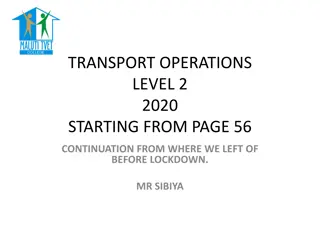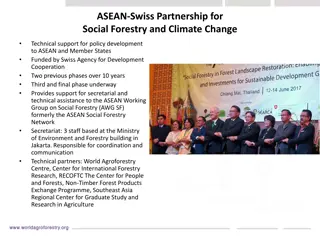Ownership and Control Regulations in ASEAN Air Transport Industry
The content discusses ownership and control restrictions in the air transport industry across ASEAN countries, outlining foreign ownership limits and regulations. It highlights the need for liberalization to align with the ASEAN Comprehensive Investment Agreement (ACIA). Various ownership models are proposed, including full liberalization, ASEAN investor ownership, and a hybrid approach. The importance of protecting consumer interests and developing related activities such as maintenance and engineering services is emphasized.
Download Presentation

Please find below an Image/Link to download the presentation.
The content on the website is provided AS IS for your information and personal use only. It may not be sold, licensed, or shared on other websites without obtaining consent from the author.If you encounter any issues during the download, it is possible that the publisher has removed the file from their server.
You are allowed to download the files provided on this website for personal or commercial use, subject to the condition that they are used lawfully. All files are the property of their respective owners.
The content on the website is provided AS IS for your information and personal use only. It may not be sold, licensed, or shared on other websites without obtaining consent from the author.
E N D
Presentation Transcript
Ownership Restrictions in Commercial Presence Selling and Marketing of Air Transport Services Existing Domestic Regulations Brunei Cambodia No commitment No commitment 49 percent foreign ownership 100 percent foreign ownership allowed Indonesia Maximum foreign equity of 49 percent. 49 percent foreign ownership. Indonesian shareholders should be a single majority. HR Director should be Indonesian. 49 percent foreign ownership Lao PDR Up to 100 percent foreign ownership Malaysia No limitation of market access and national treatment 45% foreign ownership for Malaysian Airlines. Maximum ownership of a single foreign entity is limited to 20%. 49% for other airlines. 100 percent foreign ownership allowed Myanmar No clear commitments Philippines Singapore No commitments Unbound participation of up to 70 percent. Foreign equity not exceeding 49% of the registered capital and the number of foreign shareholders must be less than half of the total shareholders No limitation on market access and no limition on national commitment 40 percent foreign ownership 49 percent foreign ownership but with foreign equity Thailand 49 percent foreign ownership Vietnam 49 percent for the registered capital. One single individual or legal entity shall not exceed more than registered capital. 30 percent of the
FDI Restrictiveness Index on Air Industry (Asean-Dialogue Partners) 0.9 0.8 0.7 0.6 0.5 0.4 0.3 0.2 0.1 0 United Kingdo m Australi a China PR Germa ny Netherl ands RussiaSwitzerl United States Cambo dia Indones ia Lao PDR Malaysi a Myanm ar Philippi nes Viet Nam India Japan Korea and 2010 0.475 0.68 0.325 0.813 0.65 0.55 0.225 0.65 0.25 0.225 0.65 0 0.56 0 0.438 0 0.665 0.77 2011 0.475 0.68 0.325 0.813 0.65 0.55 0.225 0.65 0.25 0.225 0.65 0 0.56 0 0.438 0 0.665 0.77 2012 0.475 0.68 0.325 0.563 0.65 0.55 0.225 0.65 0.25 0.225 0.65 0 0.56 0 0.438 0 0.665 0.77 2013 0.475 0.68 0.325 0.563 0.65 0.55 0.225 0.65 0.25 0.225 0.65 0 0.56 0 0.438 0.46 0.665 0.77 2014 0.455 0.68 0.325 0.563 0.65 0.55 0.225 0.65 0.25 0.225 0.65 0 0.56 0 0.438 0.46 0.665 0.77 2015 0.455 0.655 0.325 0.475 0.65 0.55 0.225 0.65 0.25 0.225 0.65 0 0.56 0 0.438 0.46 0.665 0.52 2016 0.455 0.655 0.325 0.28 0.65 0.55 0.225 0.65 0.25 0.225 0.65 0.11 0.498 0.173 0.438 0.46 0.665 0.52 2017 0.455 0.655 0.325 0.28 0.65 0.55 0.225 0.65 0.25 0.225 0.65 0.11 0.498 0.143 0.438 0.01 0.665 0.52
The liberalisation will be in-line with the spirit of the ACIA which seeks to make ASEAN as a single investment destination. Leave the so-called flag carriers out of the liberalisation process. Access to capital. To ensure consumer interests are protected against unfair practices and potential price fixing, each corporate exercise involving airlines ownership and control may be subject to regulatory scrutiny. There are at least 3 options for ASEAN to achieve the liberalisation of ownership and control. One is by allowing full liberalisation, meaning 100% foreign ownership. This will meet with objections as some may argue that ASEAN airlines should remain within ASEAN ownership and control. Another is by allowing 100% ownership by ASEAN Investors as defined in the ACIA. The third mode, to be in-line with the AFAS, ASEAN may allow up to 70% ownership by ASEAN Investors, leaving 30% to be owned by nationals of the country where the airlines is registered. Assist ASEAN Member States to grow other related activities such as the maintenance, repair and overhaul (MRO), engineering services and catering services. Development of ASEAN based airlines semi-skill workers and professionals beyond pilots and air crews.























